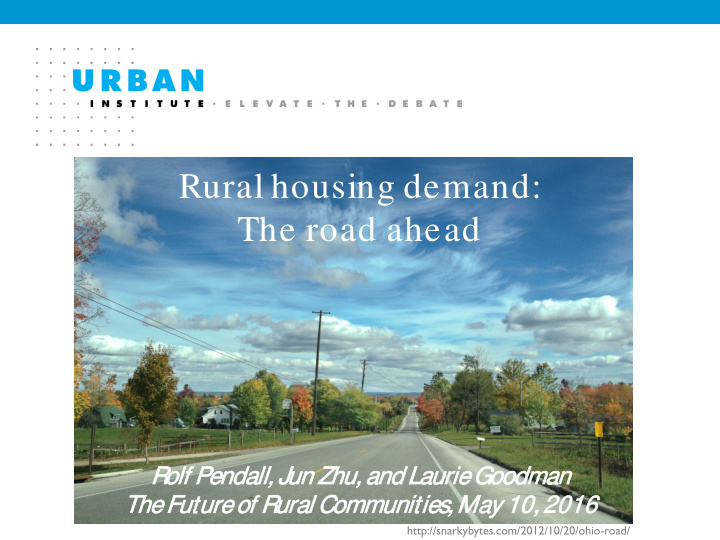



Rural housing demand: The road ahead Rolf Penda ndall, J Jun Z un Zhu, hu, a and L nd Laur urie G Goodm dman The he F Fut utur ure o of Rur ural Communi unities, May 1 10, 2016 http://snarkybytes.com/2012/10/20/ohio-road/
Main takeaways Growth and affordability Non-metro growing, but more slowly than metro areas More owner than renter growth in the 2010s in non-metro areas Affordable housing need will increase, especially for rentals Aging Seniors will head over 40% of non-metro households by 2030 All divisions growing seniors, none growing non-seniors Diversity Non-metro counties less diverse now than metro counties were in 1990, reflecting and reinforcing slow growth and aging Every division will see significant growth in nonwhite households
3 Growth and Affordability
Non-metro population steady to 2040; metro population grows 57M Millions 350 Metro 300 250 US Population 200 150 100 50 Non -metro 0 2000 2010 2020(p) 2030(p) 2040(p) Source: US Census Bureau, Census of Population & Housing 1990, 2000, 2010; Census Bureau & Urban Institute population projections
In 14 states, non-metro areas likely to lose population between 2015 and 2030 Source: Urban Institute population projections
6 Non-metro household growth continues to 2040 … Millions 25 ds holds 20 useho Hous 15 on-metro H 10 Non 5 0 1990 2000 2010 2020(p) 2030(p) 2040(p) Source: US Census Bureau, Census of Population & Housing 1990, 2000, 2010; Urban Institute projections
7 … generating new demand for both owner-occupied and rental housing. 25 Millions ds holds 20 useho Hous 15 on-metro H 10 Non 5 0 1990 2000 2010 2020(p) 2030(p) 2040(p) Owners Renters Source: US Census Bureau, Census of Population & Housing 1990, 2000, 2010; Urban Institute projections
8 Non-metro household growth in all Census divisions R ocky Mtns. fastest, New England, Great Lakes more slowly Source: Urban Institute projections
9 As households grow, so will demand for affordable rentals and owner-occupied homes 10 Millions e erate ds Low-Moder holds 8 useho 6 Hous etro Lo ncome H 4 on-met 2 Inc Non 0 2010 2020 2030 2010 2020 2030 Renters Owners Household income as a percent of area median <30% 30-50% 50-80% 80-115% Source: US Census Bureau, Census of Population & Housing 2010, ACS 2014; Urban Institute projections
10 10 Aging
11 11 Over a quarter of non-metro population will be at least 65 years old by 2030. 30% Non-metro Percent of population 65+ 25% Metro 20% 15% 10% 5% 0% 2000 2010 2020(p) 2030(p) 2040(p) Source: US Census Bureau, Census of Population & Housing 1990, 2000, 2010; Urban Institute projections
12 12 As non-metro senior population rises, non-senior population will decline. Millions 45 Non-metropolitan Population 40 35 <65 30 25 20 15 65+ 10 5 0 2000 2010 2020(p) 2030(p) 2040(p)
13 13 Over two-fifths of non-metro households will be senior-headed by 2030. Millions 25 20 ds holds 15 useho Hous 10 5 0 1990 2000 2010 2020(p) 2030(p) 2040(p) Under 65 65 and older Source: US Census Bureau, Census of Population & Housing 1990, 2000, 2010; Urban Institute projections
14 14 Every division will rapidly gain senior households in non-metro areas from 2015 to 2030.
15 15 Every division will lose non-senior households in non-metro areas from 2015 to 2030.
16 16 Diversity
17 17 Non-metro America was less racially diverse in 2010 than metro America was in 1990. 100% Percent of households by race 90% 80% 70% 60% 50% 89% 86% 84% 40% 79% 73% 68% 30% 20% 10% 0% Metro Non-met Metro Non-met Metro Non-met 1990 2000 2010 White Black Hispanic Other Source: US Census Bureau, Census of Population & Housing 1990, 2000, 2010
18 18 Rural households diversify but remain mostly white. Millions 25 20 ds holds 15 useho Hous 10 5 0 1990 2000 2010 2020(p) 2030(p) 2040(p) White Nonwhite Source: US Census Bureau, Census of Population & Housing 1990, 2000, 2010; Urban Institute projections
19 19 By 2030, rural households in faster-growth divisions will be 25-30% nonwhite Source: US Census Bureau, Census of Population & Housing 2010; Urban Institute projections
20 20 Every division will experience fast growth in nonwhite households Source: US Census Bureau, Census of Population & Housing 2010; Urban Institute projections
21 21 Recap and Housing Implications
Recap and implications Recap Household growth: Slowing, but still significant Senior households rising, non-seniors declining Diversity growing in every region as white non-Hispanics decline Housing implications Urgent need for reinvestment in older rural housing, often occupied by seniors Housing demand will exceed household growth: housing left behind by seniors, out-migrants won’t work for all new households Need for affordable rural housing will grow— especially in aging, diversifying rural areas where income growth may lag
Recommend
More recommend